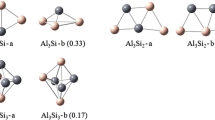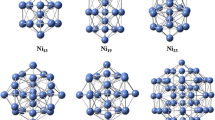Abstract
Context
Mixed-metal clusters have long been studied because of their peculiar properties and how they change with cluster size, composition, and charge state and their potential roles in catalysis. The characterization of these clusters is therefore a very important issue. One of the main experimental tools for characterizing their electronic structure is photoelectron spectroscopy. Theoretical computation completes the task by fully determining the structural properties and matching the theoretical predictions to the measured spectra. We present density functional theory computations of the structural, magnetic, and electronic properties of negatively charged mixed AlnNi- clusters with up to 13 Al atoms. The lowest energy structures of the anionic clusters with up to 7 atoms are also found to be low-energy isomers of the neutral counterparts found in the literature. The 13-atom cluster is found to be a quartet and a perfect icosahedron. The predicted photoelectron spectra are also presented and can be used to interpret future experimental data. We also presented indicators that can be used to determine the potential of these systems for single-atom catalysis. These indicators point to smaller clusters to be more reactive as the gap between the Fermi energy and the center of the d-band increases with cluster size and that Ni occupies an internal site for n = 11–13. We speculate that reactivity can be enhanced if one adds an additional Ni atom.
Methods
The DFT calculations were performed using the Becke exchange and Perdew-Wang/91 correlation functionals (BPW91), a DFT-optimized all-electron basis set for the aluminum atom, and the Stuttgart small core pseudopotential for the Ni atom. All of the computations used the Gaussian 03 software.









Similar content being viewed by others

Data availability
All data underlying the results are available as part of the article and no additional source data are required.
References
Ferrando R, Jellinek J, Johnston RL (2008) Nanoalloys: from theory to applications of alloy clusters and nanoparticles. Chem Rev 108(3):845–910
Chakraborty I, Pradeep T (2017) Atomically precise clusters of noble metals: emerging link between atoms and nanoparticles. Chem Rev 117(12):8208–8271
Jena P, Sun Q (2018) Super atomic clusters: design rules and potential for building blocks of materials. Chem Rev 118(11):5755–5870
Tyo EC, Vajda S (2015) Catalysis by clusters with precise number of atoms. Nature Nanotech 10:577–588
Luo Z, Castleman AW Jr, Khanna SN (2016) Reactivity of metal clusters. Chem Rev 116(23):14456–14492
Yang X-F, Wang A, Botao Qiao B, Li J, Liu J, Zhang T (2013) Single-atom catalysts: a new frontier in heterogeneous catalysis. Acc Chem Res 46(8):1740–1748
Liu L, Corma A (2018) Metal catalysts for heterogeneous catalysis: from single atoms to nanoclusters and nanoparticles. Chem Rev 118(10):4981–5079
Rodríguez-Kessler PL, Rodríguez-Domínguez AR (2016) Structures and electronic properties of TinV (n = 1–16) clusters: first-principles calculations. J Phys Chem A 120(15):2401–2407
Rodríguez-Kessler PL, Pan S, Florez E, Cabellos JL, Merino G (2017) Structural evolution of the rhodium-doped silver clusters AgnRh (n ≤ 15) and their reactivity toward NO. J Phys Chem C 121(35):19420–19427
Rodríguez-Kessler PL, Alonso-Dávila P, Navarro-Santos P, Morato-Márquez JA, Ortíz-Chi F, Rodríguez-Domínguez AR (2019) Hydrogen chemisorption on Pd-doped copper clusters. J Phys Chem C 123(25):15834–15840
Rodríguez-Kessler PL, Rodríguez-Domínguez AR, Morato-Márquez JA, Ortiz-Chi F, Carey DM, Muñoz-Castro A (2020) On the search of small Cu-Ru atomically precise superatoms. Cu10Ru cluster as a stable 18-ve endohedral structure. Chem Phys Let 754:137721
Rodríguez-Kessler PL, Muñoz-Castro A (2023) Structure and stability of Mo-doped Cun (n = 1–12) clusters: DFT calculations. Inorg Chim Acta 556:121620
Acioli PH, Jellinek J (2017) Theoretical analysis of photoelectron spectra of pure and mixed metal clusters: disentangling size, structure and composition effects. J Chem Phys C 121:16665–16672
Acioli PH, Jellinek J (2022) A computational study of Aln− and Aln−1Pt− clusters: the effects of doping and a uniform tuning gauge for single-atom nanocatalysts. Eur Phys J D 76(12):230
Cha C-Y, Ganteför G, Eberhardt W (1992) New experimental setup for photoelectron spectroscopy on cluster anions, Rev Sci Instrum 63:5661–5666
Lineberger WC (2013) Once upon anion: a tale of photodetachment. Ann Rev Phys Chem 64:21–36
Chen TT, Cheung LF, Wang LS (2022) Probing the nature of the transition-metal-boron bonds and novel aromaticity in small metal-doped boron clusters using photoelectron spectroscopy. Ann Rev Phys Chem 73:233–253
Acioli PH, Zhang X, Bowen KH Jr, Jellinek J (2022) Electron binding energy spectra of AlnPt- clusters - a combined experimental and computational study. J Phys Chem A 126(26):4241–4247
Acioli PH (2020) Predicting the photoelectron spectrum of quasi octahedral Al6Mo– cluster. ChemistryOpen 9:545–549
Acioli PH, Zhang X, Bowen KH Jr, Jellinek J (2019) Electron binding energy spectra of AlnMo– clusters: measurements, calculations, and theoretical analysis. J Phys Chem C 123(13):7810–7817
Calleja M, Rey C, Alemany MMG, Gallego LJ, Ordejon P, Sánchez-Portal D, Artacho E, Soler JM (1999) Phys Rev B 60(3):2020–2024
Wen J-Q, Jiang Z-Y, Li J-Q, Cao L-K, Chu S-Y (2010) Int J Quant Chem 110(7):1368–1375
Song W, Wang B, Guo K, He C (2016) In energy science and applied techology ESAT 2016, Ed. Feng Z, pp 361-364
Ma Z-W, Li B-X (2015) Comp Theor Chem 1068:88–96
Krissinel EB, Jellinek J (1997) Chem Phys Lett 301(3–4):301–312
Krissinel EB, Jellinek J (1997) Int J Quant Chem 62(2):185–197
Rey C, Garcia-Rodeja J, Gallego LJ (1996) Phys Rev B 54(1):2942–2948
Lloyd LD, Johnston R (1998) Chem Phys 236(1–3):107–121
Bailey MS, Wilson NT, Roberts C, Johnston RL (2003) Eur Phys J D 25(2):41–55
Wang X, Adeleke AA, Cao W, Luo Y, Zhang M, Yao Y, Y, (2016) Structures of nanoalloy clusters AunAln (n = 1–10) and the growth patterns to the bulk phase. J Phys Chem C 120(44):25588–25595
Khetrapal NS, Jian T, Pal R, Lopez GV, Pande S, Wang L-S, Zeng XC (2016) Probing the structures of gold–aluminum alloy clusters AuxAly−: a joint experimental and theoretical study. Nanoscale 8:9805–9814
Becke AD (1988) Density-functional exchange-energy approximation with correct asymptotic behavior. Phys Rev A 38(6):3098–3100
Perdew JP, Wang Y (1992) Accurate and simple analytic representation of the electron-gas correlation energy. Phys Rev B 45(23):13244-13249
Sosa C, Andzelm J, Elkin BC, Wimmer E, Dobbs KD, Dixon DA (1992) A local density functional study of the structure and vibrational frequencies of molecular transition-metal compounds. J Phys Chem 96(16):6630–6636
Dolg M, Wedig U, Stoll H, Preuss H (1987) Energy-adjusted ab initio pseudopotentials for the first row transition elements. J Chem Phys 86:866–872
Frisch MJ, Trucks GW, Schlegel HB, Scuseria GE, Robb MA, Cheeseman JR, Montgomery Jr. JA, Vreven T, Kudin KN, Burant JC et al (2004) Gaussian 03, Revision C.02; Gaussian, Inc.: Wallingford CT
Jellinek J, Acioli PH (2003) Converting Kohn-Sham eigenenergies into electron binding energies. J Chem Phys 118:7783
Wen J-Q, Zhang J-M, Chen G-X, Mang C-J, Wen Z-Y (2016) Computational research of Nin+1, Aln+1, AlnNi, AlnNi2 (n = 1–7) clusters by density functional theory. Comp Theo Chem 15:44–51
Acknowledgements
This work was supported by the Northeastern Illinois University Department of Physics and Astronomy.
Author information
Authors and Affiliations
Contributions
Paulo H Acioli performed all the calculations, prepared all the tables and figures and the analysis in the submitted manuscript.
Corresponding author
Ethics declarations
Competing interests
The authors declare no competing interests.
Conflict of interest
The author declares no competing interests.
Additional information
Publisher's Note
Springer Nature remains neutral with regard to jurisdictional claims in published maps and institutional affiliations.
Supplementary Information
Below is the link to the electronic supplementary material.
Rights and permissions
Springer Nature or its licensor (e.g. a society or other partner) holds exclusive rights to this article under a publishing agreement with the author(s) or other rightsholder(s); author self-archiving of the accepted manuscript version of this article is solely governed by the terms of such publishing agreement and applicable law.
About this article
Cite this article
Acioli, P.H. Theoretical prediction of low-energy photoelectron spectra of AlnNi− clusters (n = 1–13). J Mol Model 30, 155 (2024). https://doi.org/10.1007/s00894-024-05944-x
Received:
Accepted:
Published:
DOI: https://doi.org/10.1007/s00894-024-05944-x



